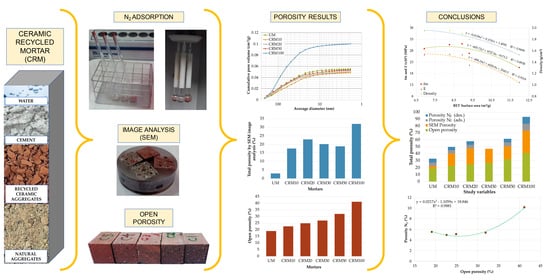Recycled Mortars with Ceramic Aggregates. Pore Network Transmutation and Its Relationship with Physical and Mechanical Properties
Abstract
1. Introduction
2. Materials and Methods
2.1. Materials
2.2. Properties of Study Aggregates
2.3. Mortar Mixes
2.4. Physical and Mechanical Properties Tests
2.5. Nitrogen (N2) Adsorption Porosimetry
2.6. Porosity by SEM and Microanalysis of Chemical Elements with an Energy Dispersive Spectrometer (SEM-EDS)
2.7. Image Analysis (Obtained with Scanning Electron Microscope—SEM), Using NI Vision Assistant
3. Results and Discussion
3.1. Physical and Mechanical Properties of CRMs
3.2. Porosimetry by N2 Adsorption
3.3. Porosimetry by SEM Image Analysis
3.4. Total Open Porosity
3.5. Correlations between Porosimetry Techniques
4. Conclusions
- The incremental variability of the porosity in the CRMs (increase directly correlated with the increase in CA percentage content), is validated by the different test techniques used; in particular with that of open porosity and that of N2 adsorption.
- The results obtained from the open porosity calculation correlate best with the behavior of the CRMs—percentage of CA addition as well as with the results obtained from the physical and mechanical properties of the CRMs.
- The N2 adsorption test provides information related to the amount of adsorbed gas, pore size distribution (diameter/radius), BET surface area, diversity of pore radius types, etc., which can be used to analyze or compare with respect to the physical and mechanical properties of CRMs. The technique can be considered with a contribution of important diversity of parameters that can be used to understand the effect of the porous network of mortars.
- The properties such as fm, E and density of the CRMs, presented the best fit with the variable of rave porosity, (in adsorption phase); while absorption and drying shrinkage, with respect to rmax. The former because it is a variable of general representation of the porous network with incidence on properties on which the whole mortar matrix has an impact; and the latter, because it is a parameter on which the related properties have an impact on the capacity of water mobility.
- The BET surface area with respect to physical and mechanical properties, established acceptable coefficients R2 (R2 ≅ 1), as well as equations that generate a trace of its curve coincident to the points of the related variables.
- Porosity results obtained with SEM image analysis do not show an evident correlation with respect to physical and mechanical properties of CRMs; they are so for the extreme variables (UM and CRM100), but without evident order for the rest. This is attributed to the image analysis process itself.
- It is determined that the open porosity technique is the one that provides the most reliable data, which can help to better explain the physical and mechanical behavior of the CRMs, followed by the N2 adsorption analysis technique, and finally the SEM image analysis technique.
- It is suggested that the optimal percentage of CA to be used in CRMs is 20%, which will guarantee similar properties to UMs.
Author Contributions
Funding
Institutional Review Board Statement
Informed Consent Statement
Data Availability Statement
Acknowledgments
Conflicts of Interest
Abbreviations
| rave | Average radius |
| BEI | Backscattered Electron Image |
| BJH | Barrett, Joyner and Halenda |
| BET | Brunauer, Emmett and Teller |
| c:a | Cement:aggregate ratio |
| R2 | Coefficient of determination R2 |
| fm | Compressive strength |
| C&D | Construction and Demolition |
| CDW | Construction and Demolition Waste |
| rcri | Critical radius |
| A | Cumulative pore area |
| V | Cumulative pore volume |
| EDS | Energy Dispersive Spectrometer |
| ITZ | Interfacial Transition Zone |
| IUPAC | International Union of Pure and Applied Chemistry |
| rmax | Maximum radius |
| rmed | Medium radius |
| MIP | Mercury Intrusion Porosimetry |
| rmin | Minimum radius |
| E | Modulus of Elasticity |
| NA | Natural Aggregate |
| N2 | Nitrogen |
| OD | Oven-Dry condition |
| CA | Recycled Ceramic Aggregate |
| CRM | Recycled Ceramic Mortars |
| SSD | Saturation-Surface-Dry condition |
| SEM | Scanning Electron Microscopy |
| SEI | Secondary Electron Image |
| UM | Usual Mortar |
| Vads | Volume adsorption phase |
| Vdes | Volume desorption phase |
| w/c | Water:cement ratio |
| EDX | X-Ray Diffraction |
References
- Bektas, F.; Wang, K.; Ceylan, H. Effects of crushed clay brick aggregate on mortar durability. Constr. Build. Mater. 2009, 23, 1909–1914. [Google Scholar] [CrossRef]
- Wang, G.; Tian, B. Effect of waste ceramic polishing powder on the properties of cement mortars. In Proceedings of the 2009 International Conference on Energy and Environment Technology, ICEET 2009, Guilin, China, 16–18 October 2009; IEEE Computer Society: Washington, DC, USA, 2009; pp. 101–104. [Google Scholar]
- Silva, J.; De Brito, J.; Veiga, R. Recycled Red-Clay Ceramic Construction and Demolition Waste for Mortars Production. J. Mater. Civ. Eng. 2010, 22, 236–244. [Google Scholar] [CrossRef]
- Lehmann, S. Optimizing Urban Material Flows and Waste Streams in Urban Development through Principles of Zero Waste and Sustainable Consumption. Sustainability 2011, 3, 155–183. [Google Scholar] [CrossRef]
- Jiménez, J.; Ayuso, J.; López, M.; Fernández, J.; de Brito, J. Use of fine recycled aggregates from ceramic waste in masonry mortar manufacturing. Constr. Build. Mater. 2013, 40, 679–690. [Google Scholar] [CrossRef]
- Lu, G.; Fan, Z.; Sun, Z.; Liu, P.; Leng, Z.; Wang, D.; Oeser, M. Improving the polishing resistance of cement mortar by using recycled ceramic. Resour. Conserv. Recycl. 2020, 158, 104796. [Google Scholar] [CrossRef]
- Liu, Q.; Singh, A.; Xiao, J.; Li, B.; Tam, V.W. Workability and mechanical properties of mortar containing recycled sand from aerated concrete blocks and sintered clay bricks. Resour. Conserv. Recycl. 2020, 157, 104728. [Google Scholar] [CrossRef]
- Corinaldesi, V.; Giuggiolini, M.; Moriconi, G. Use of rubble from building demolition in mortars. Waste Manag. 2002, 22, 893–899. [Google Scholar] [CrossRef]
- Silva, J.; De Brito, J.; Veiga, R. Fine ceramics replacing cement in mortars Partial replacement of cement with fine ceramics in rendering mortars. Mater. Struct. 2007, 41, 1333–1344. [Google Scholar] [CrossRef]
- Naceri, A.; Hamina, M.C. Use of waste brick as a partial replacement of cement in mortar. Waste Manag. 2009, 29, 2378–2384. [Google Scholar] [CrossRef]
- Moriconi, G.; Corinaldesi, V.; Antonucci, R. Environmentally-friendly mortars: A way to improve bond between mortar and brick. Mater. Struct. 2003, 36, 702–708. [Google Scholar] [CrossRef]
- Pereira-De-Oliveira, L.A.; Castro-Gomes, J.P.; Santos, P.M. The potential pozzolanic activity of glass and red-clay ceramic waste as cement mortars components. Constr. Build. Mater. 2012, 31, 197–203. [Google Scholar] [CrossRef]
- Li, L.G.; Lin, Z.H.; Chen, G.M.; Kwan, A.K.H. Reutilizing clay brick dust as paste substitution to produce environment-friendly durable mortar. J. Clean. Prod. 2020, 274, 1–11. [Google Scholar] [CrossRef]
- Ge, Z.; Feng, Y.; Zhang, H.; Xiao, J.; Sun, R.; Liu, X. Use of recycled fine clay brick aggregate as internal curing agent for low water to cement ratio mortar. Constr. Build. Mater. 2020, 264, 120280. [Google Scholar] [CrossRef]
- Silva, J.; de Brito, J.; Veiga, R. Incorporation of fine ceramics in mortars. Constr. Build. Mater. 2009, 23, 556–564. [Google Scholar] [CrossRef]
- Corinaldesi, V.; Moriconi, G. Behaviour of cementitious mortars containing different kinds of recycled aggregate. Constr. Build. Mater. 2009, 23, 289–294. [Google Scholar] [CrossRef]
- Corinaldesi, V. Environmentally-friendly bedding mortars for repair of historical buildings. Constr. Build. Mater. 2012, 35, 778–784. [Google Scholar] [CrossRef]
- Mohammadhosseini, H.; Lim, N.H.A.S.; Tahir, M.M.; Alyousef, R.; Alabduljabbar, H.; Samadi, M. Enhanced perfor-mance of green mortar comprising high volume of ceramic waste in aggressive environments. Constr. Build. Mater. 2019, 212, 607–617. [Google Scholar] [CrossRef]
- López Gayarre, F.; López Boadella, Í.; López-Colina Pérez, C.; Serrano López, M.; Domingo Cabo, A. Influence of the ceramic recycled agreggates in the masonry mortars properties. Constr. Build. Mater. 2017, 132, 457–461. [Google Scholar] [CrossRef]
- O’Farrell, M.; Wild, S.; Sabir, B. Pore size distribution and compressive strength of waste clay brick mortar. Cem. Concr. Compos. 2001, 23, 81–91. [Google Scholar] [CrossRef]
- Higashiyama, H.; Yagishita, F.; Sano, M.; Takahashi, O. Compressive strength and resistance to chloride penetration of mortars using ceramic waste as fine aggregate. Constr. Build. Mater. 2012, 26, 96–101. [Google Scholar] [CrossRef]
- Filho, R.T.; Gonçalves, J.; Americano, B.; Fairbairn, E. Potential for use of crushed waste calcined-clay brick as a supplementary cementitious material in Brazil. Cem. Concr. Res. 2007, 37, 1357–1365. [Google Scholar] [CrossRef]
- AENOR. UNE-EN 197-1. Cemento Parte 1: Composición, Especificaciones y Criterios de Conformidad de Los Cementos Communes; Asociación Española de Normalización y Certificación: Madrid, Spain, 2011; p. 40. [Google Scholar]
- ASTM International. C144-99. Standard Specification for Aggregate for Masonry Mortar; American Society for Testing and Materials: West Conshohocken, PA, USA, 1999; p. 2. [Google Scholar]
- ASTM International. C128-04a. Standard Test Method for Density, Relative Density (Specific Gravity), and Absorption; American Society for Testing and Materials: West Conshohocken, PA, USA, 2004; p. 6. [Google Scholar]
- ASTM International. C29/C29M–97. Standard Test Method for Bulk Density (“Unit Weight”) and Voids in Aggregate; American Society for Testing and Materials: West Conshohocken, PA, USA, 1997; p. 4. [Google Scholar]
- ASTM International. C117-95. Standard Test Method for Materials Finer than 75-µm (No. 200) Sieve in Mineral; American Society for Testing and Materials: West Con-shohocken, PA, USA, 1995; p. 4. [Google Scholar]
- ASTM International. C136-06. Standard Test Method for Sieve Analysis of Fine and Coarse Aggregates; American Society for Testing and Materials: West Conshohocken, PA, USA, 2006; p. 5. [Google Scholar]
- Cabrera-Covarrubias, F.G.; Arredondo-Rea, S.P.; Gómez-Soberón, J.M.; Almaral-Sánchez, J.L.; Corral-Higuera, R. Mechanical properties of mortars containing recycled ceramic as a fine aggregate replacement. Rev. Constr. 2015, 14, 22–29. [Google Scholar] [CrossRef]
- ASTM International. C109/C109M-05. Standard Test Method for Compressive Strength of Hydraulic Cement Mortars; American Society for Testing and Materials: West Conshohocken, PA, USA, 2005; p. 9. [Google Scholar]
- ASTM International. C230/C230M-03. Standard Specification for Flow Table for Use in Tests of Hydraulic Cement; American Society for Testing and Materials: West Conshohocken, PA, USA, 2003; p. 7. [Google Scholar]
- AENOR. UNE-EN 1015-10. Parte 10: Determinación de la Densidad Aparente en Seco Del Mortero Endurecido; Asociación Española de Normalización y Certificación: Madrid, Spain, 2000; p. 8. [Google Scholar]
- AENOR. UNE-EN 1936: Determinación de la Densidad Real y Aparente y de la Porosidad Abierta y Total; Asociación Española de Normalización y Certificación: Madrid, Spain, 2007; p. 13. [Google Scholar]
- Cabrera-Covarrubias, F.G.; Gómez-Soberón, J.M.; Almaral-Sánchez, J.L.; Arredondo-Rea, S.P.; Gómez-Soberón, M.C.; Corral-Higuera, R. An Experimental Study of Mortars with Recycled Ceramic Aggregates: Deduction and Prediction of the Stress-Strain. Materials 2016, 9, 1029. [Google Scholar] [CrossRef]
- Mendivil-Escalante, J.M.; Gómez-Soberón, J.M.; Almaral-Sánchez, J.L.; Cabrera-Covarrubias, F.G. Metamorphosis in the Porosity of Recycled Concretes Through the Use of a Recycled Polyethylene Terephthalate (PET) Additive. Correlations between the Porous Network and Concrete Properties. Materials 2017, 10, 176. [Google Scholar] [CrossRef] [PubMed]
- Sing, K.S. Reporting physisorption data for gas/solid systems with special reference to the determination of surface area and porosity (Recommendations 1984). Pure Appl. Chem. 1985, 57, 603–619. [Google Scholar] [CrossRef]
- De Belie, N.; Krátký, J.; Van Vlierberghe, S. Influence of pozzolans and slag on the microstructure of partially carbonated cement paste by means of water vapour and nitrogen sorption experiments and BET calculations. Cem. Concr. Res. 2010, 40, 1723–1733. [Google Scholar] [CrossRef]
- Quantachrome Instruments. The Gas Sorption Process. 2018. Available online: http://www.quantachrome.com/pdf_brochures/evo_07160_brochure.pdf (accessed on 10 December 2020).
- Palos, A.; D’Souza, N.A.; Snively, C.; Reidy, R.F. Modification of cement mortar with recycled ABS. Cem. Concr. Res. 2001, 31, 1003–1007. [Google Scholar] [CrossRef]
- Chinchillas-Chinchillas, M.J.; Rosas-Casarez, C.A.; Arredondo-Rea, S.P.; Gómez-Soberón, J.M.; Corral-Higuera, R. SEM Image Analysis in Permeable Recycled Concretes with Silica Fume. A Quantitative Comparison of Porosity and the ITZ. Materials 2019, 12, 2201. [Google Scholar] [CrossRef] [PubMed]
- Gómez-Soberón, J.M.V. Relationship between Gas Adsorption and the Shrinkage and Creep of Recycled Aggregate Concrete. Cem. Concr. Aggreg. 2003, 25, 1–7. [Google Scholar]
- Santos, A.R.; Veiga, M.D.R.; Silva, A.S.; de Brito, J. Microstructure as a critical factor of cement mortars’ behaviour: The effect of aggregates’ properties. Cem. Concr. Compos. 2020, 111, 103628. [Google Scholar] [CrossRef]
- Santamarina, J.C.; Klein, K.A.; Wang, Y.H.; Prencke, E. Specific surface: Determination and relevance. Can. Geotech. J. 2002, 39, 233–241. [Google Scholar] [CrossRef]
- Gómez-Soberón, J.M.V. Porosity of recycled concrete with substitution of recycled concrete aggregate: An experimental study. Cem. Concr. Res. 2002, 32, 1301–1311. [Google Scholar] [CrossRef]
- Da Silva, P.; de Brito, J. Experimental study of the porosity and microstructure of self-compacting concrete (SCC) with binary and ternary mixes of fly ash and limestone filler. Constr. Build. Mater. 2015, 86, 101–112. [Google Scholar] [CrossRef]
- Atahan, H.N.; Oktar, O.N.; Taşdemir, M.A. Effects of water–cement ratio and curing time on the critical pore width of hardened cement paste. Constr. Build. Mater. 2009, 23, 1196–1200. [Google Scholar] [CrossRef]
- Liu, C.; Liu, H.; Xiao, J.; Bai, G. Effect of old mortar pore structure on relative humidity response of recycled aggregate concrete. Constr. Build. Mater. 2020, 247, 118600. [Google Scholar] [CrossRef]
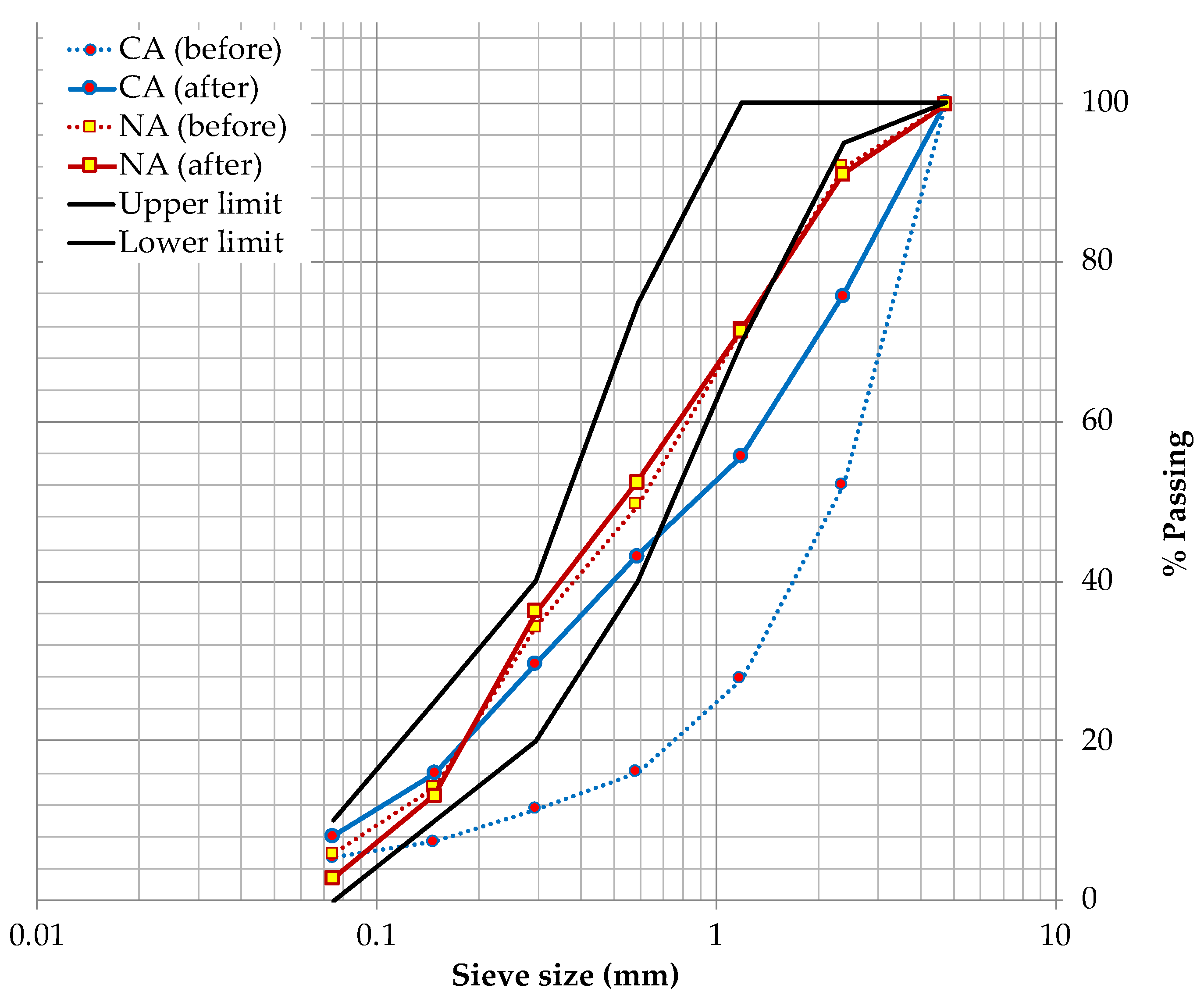
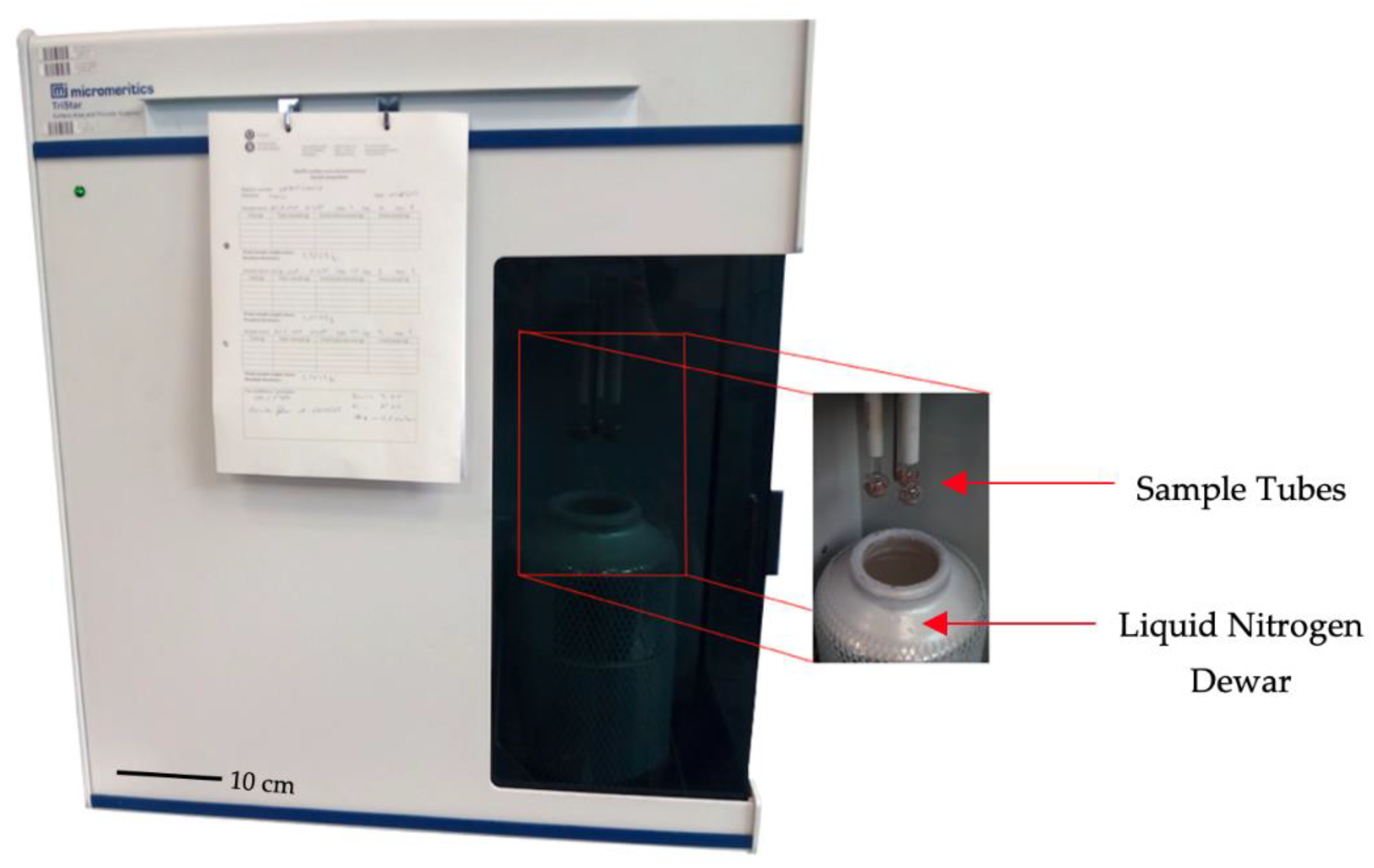

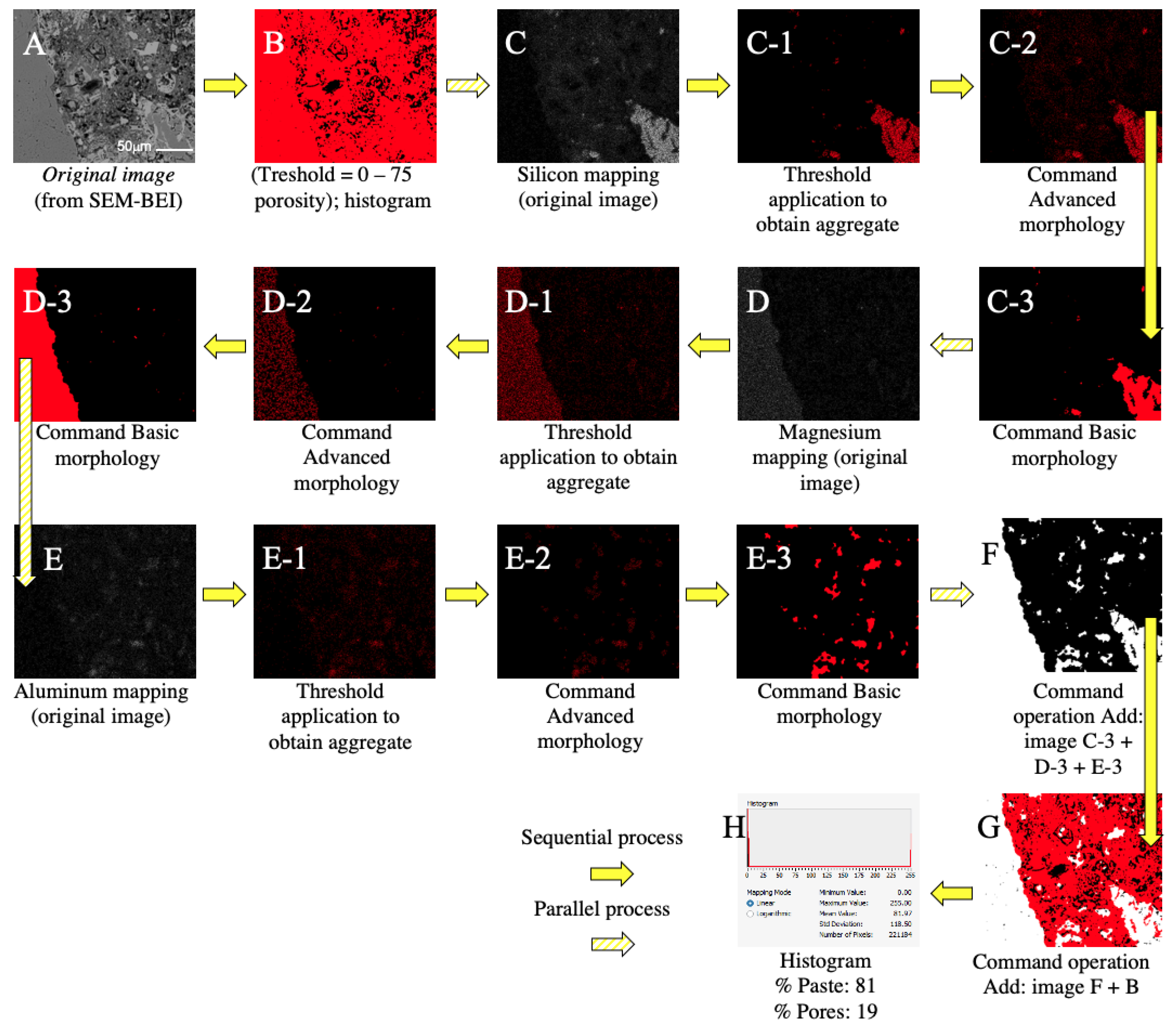
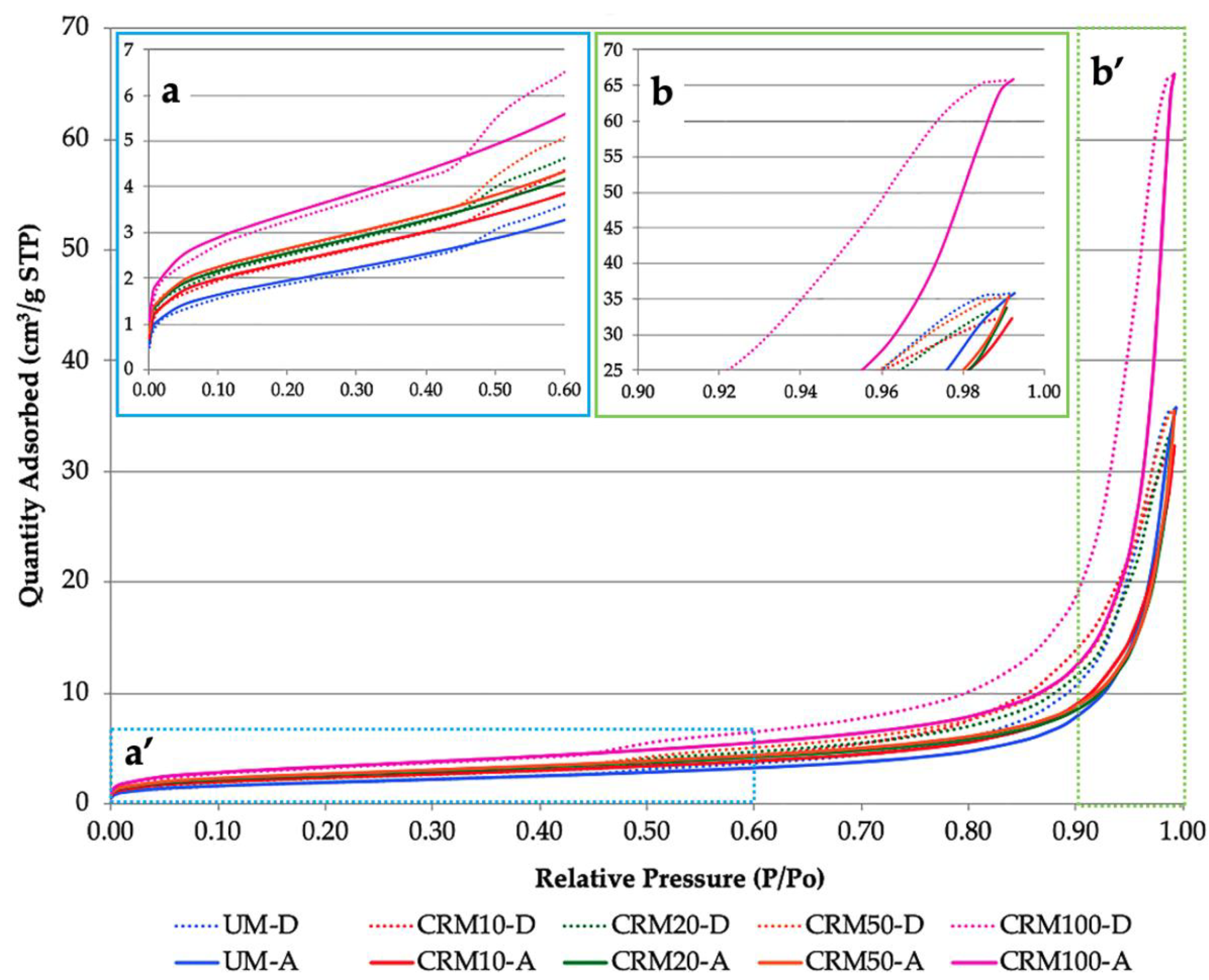
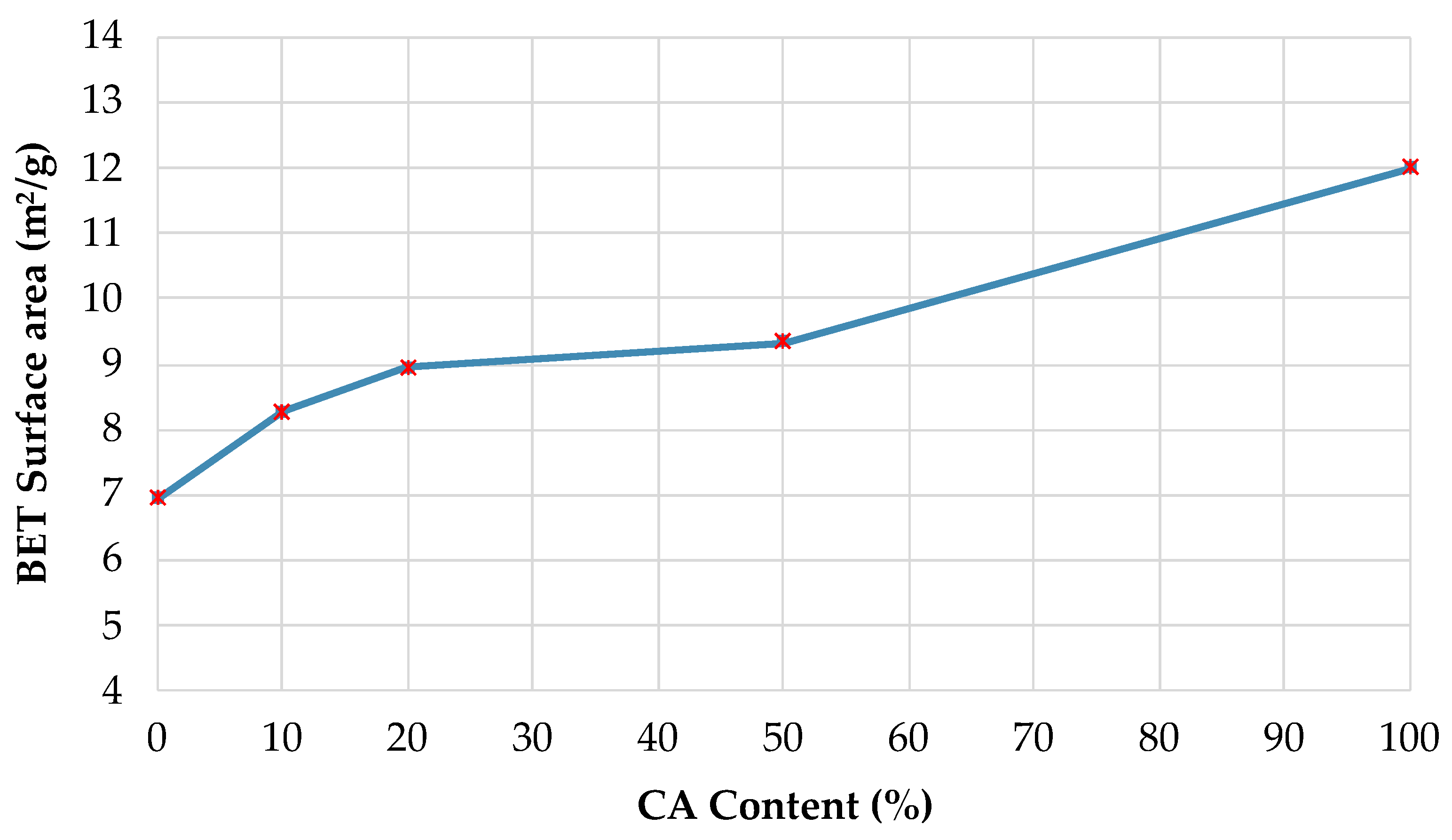
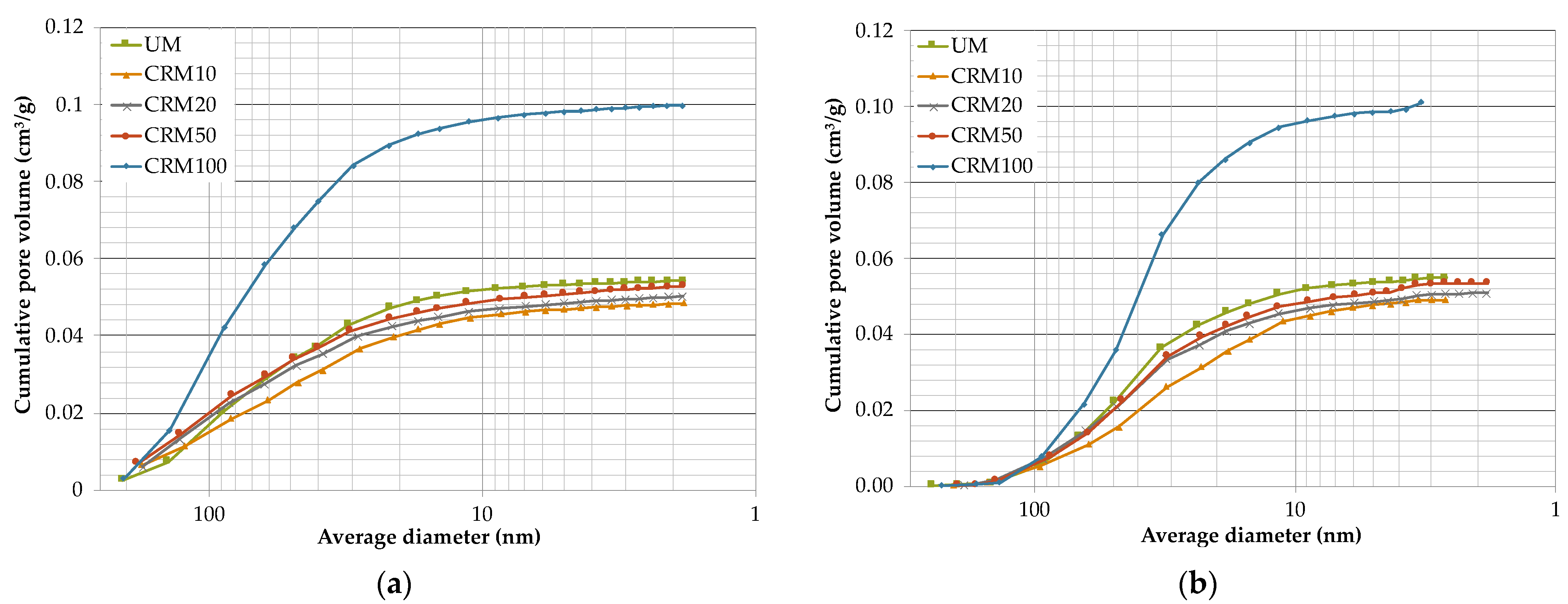

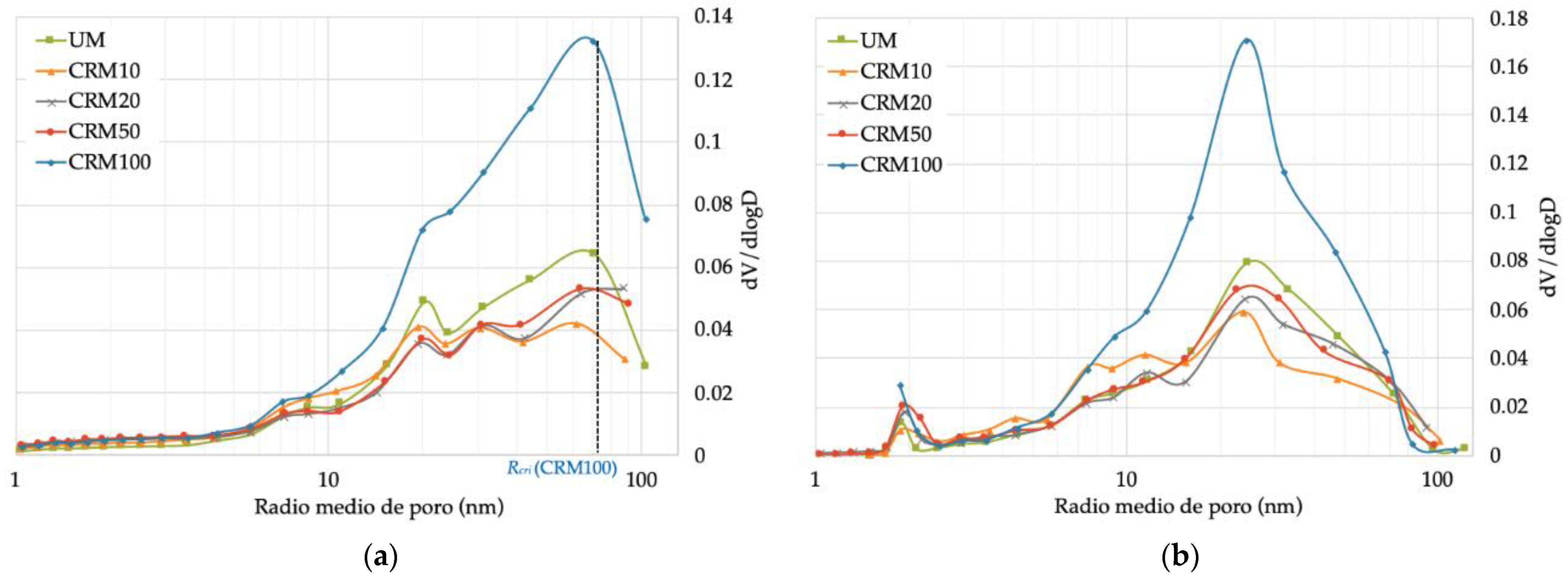

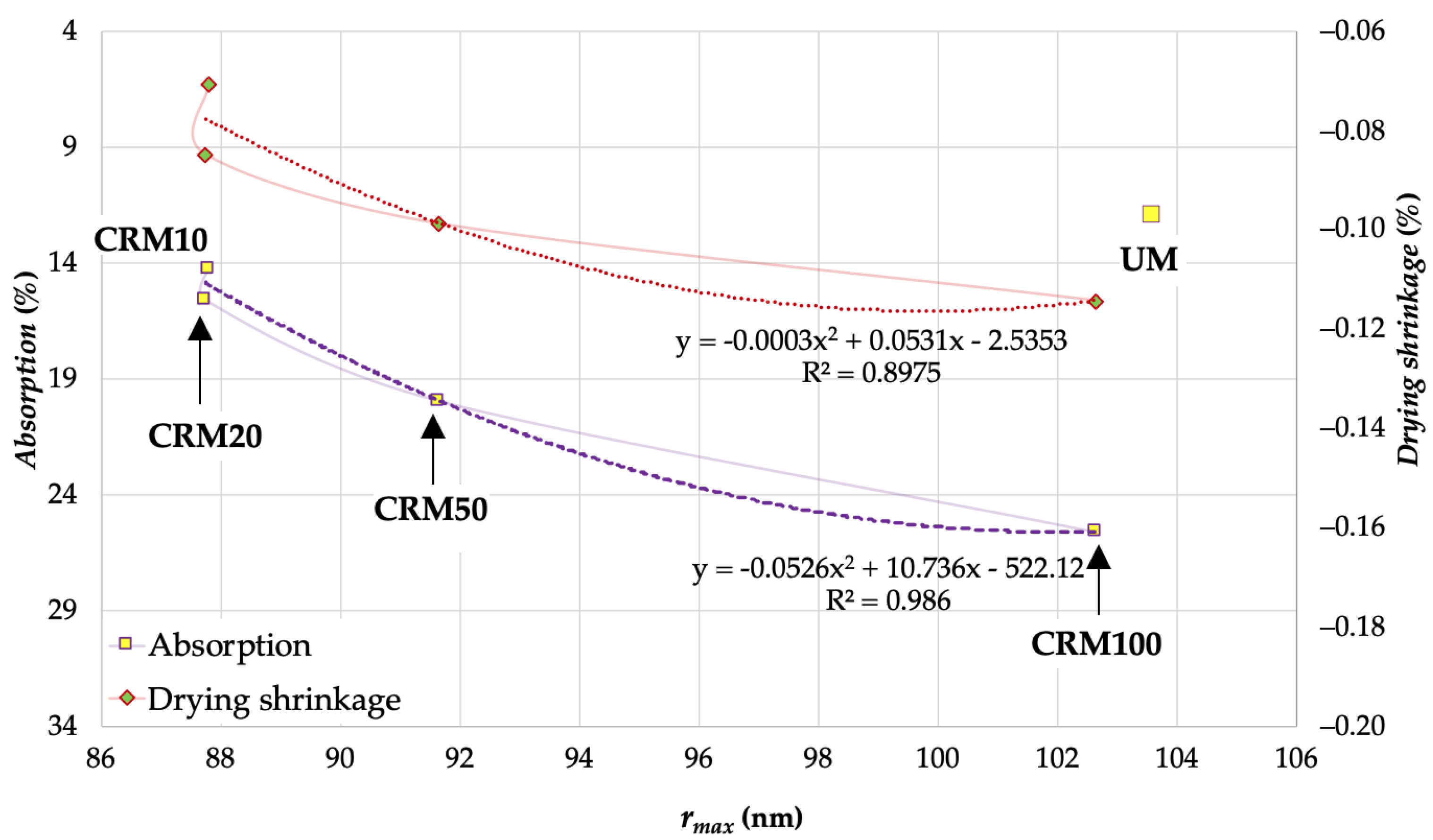

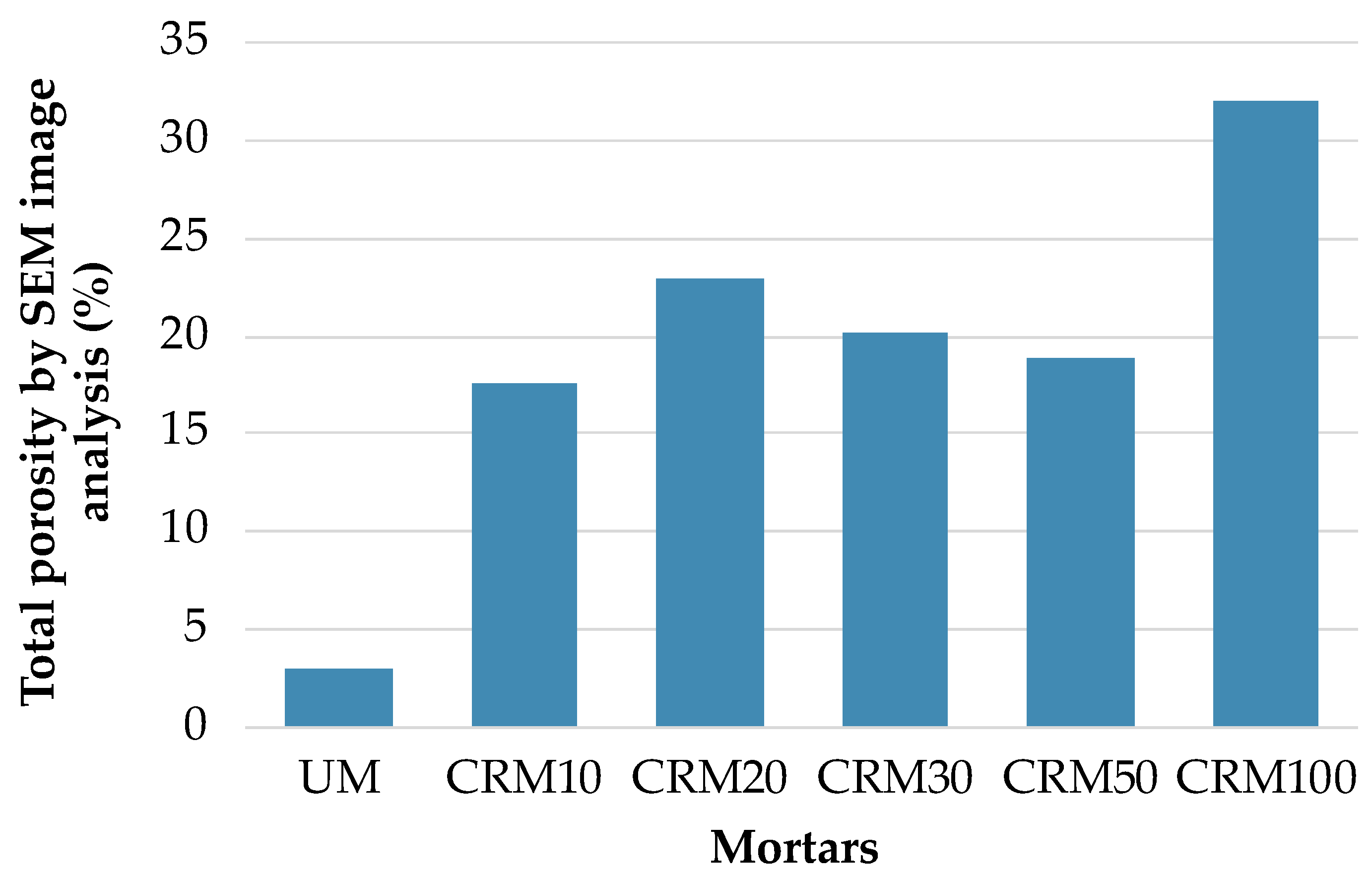


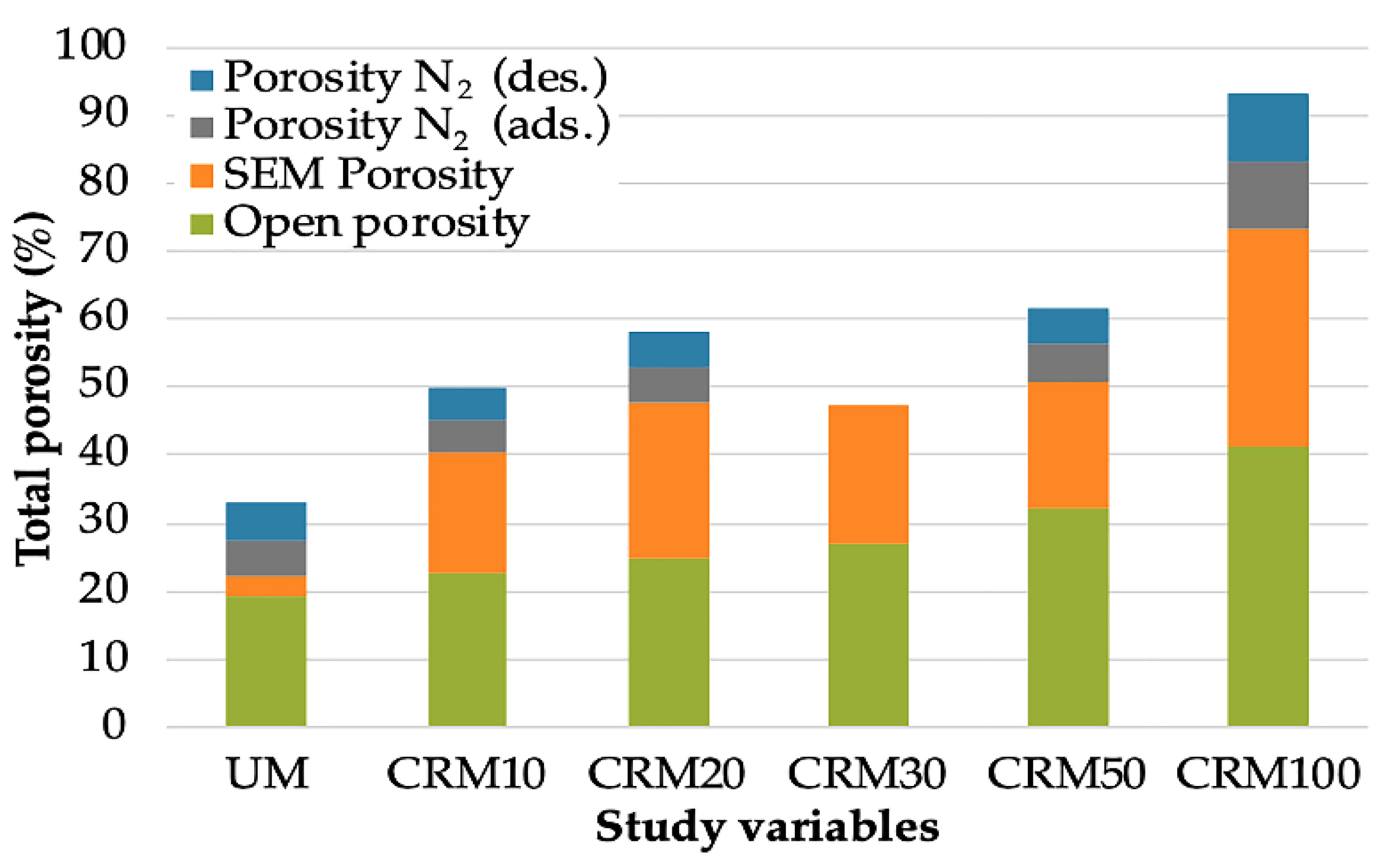
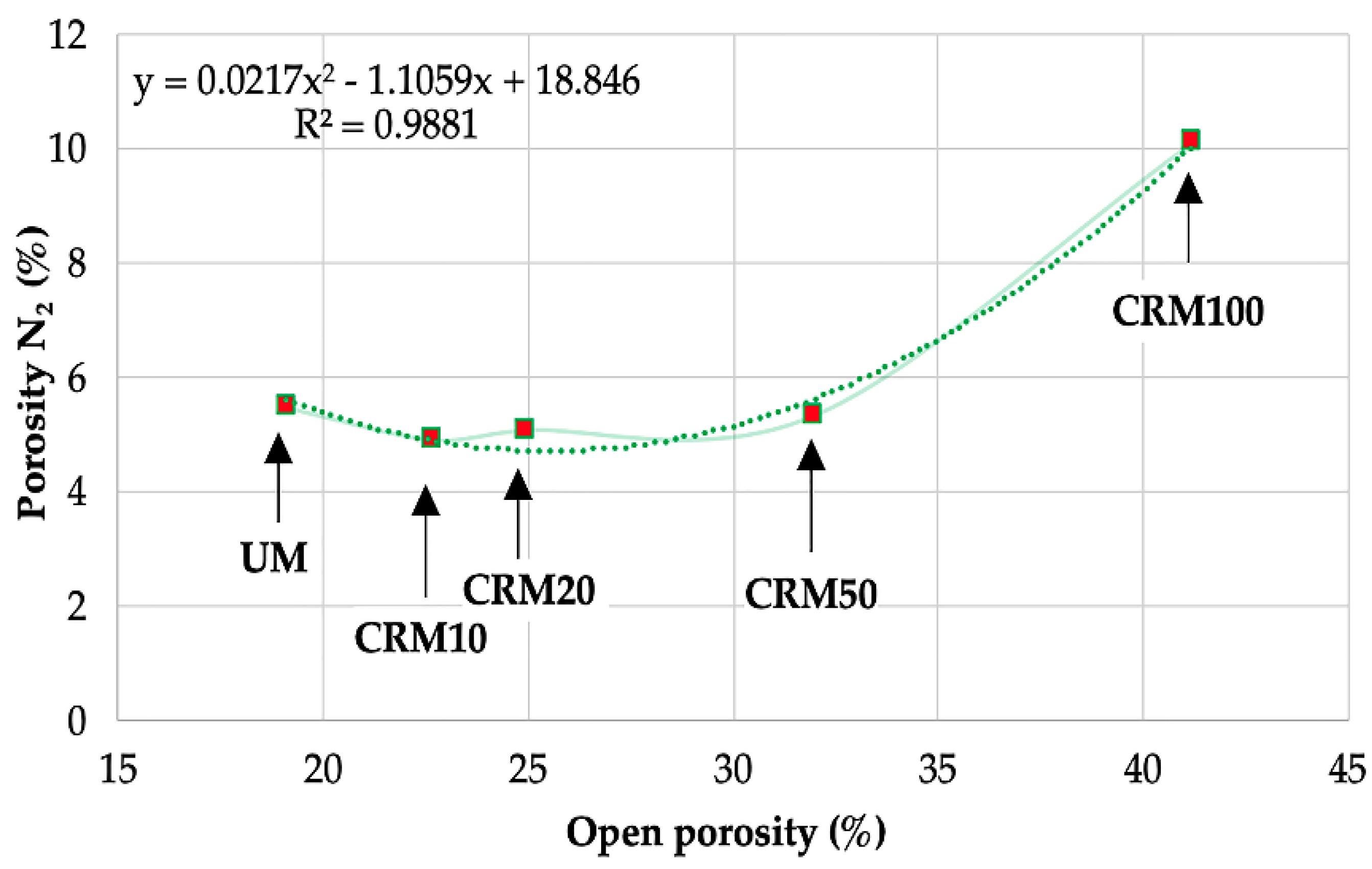
| Property | Unit | Recycled Ceramic Aggregate (CA) | Natural Aggregate (NA) |
|---|---|---|---|
| Density (OD) | Kg/cm3 | 1820.9 | 2581.6 |
| Density (SSD) | 2155.4 | 2623.6 | |
| Bulk density (OD) | 1182.0 | 1735.1 | |
| Bulk density (SSD) | 1399.1 | 1860.8 | |
| Void content | % | 35.3 | 32.9 |
| Water absorption coefficient | 18.4 | 1.6 | |
| Particles < 75 μm (sieve No. 200) | 8.2 | 2.9 | |
| Fineness modulus materials | - | 2.8 | 2.4 |
| Materials (g) | Mixtures Used for Mortars | |||||
|---|---|---|---|---|---|---|
| UM | CRM10 | CRM20 | CRM30 | CRM50 | CRM100 | |
| Cement | 400 | 433 | 381 | 372 | 348 | 323 |
| NA 1 | 800 | 780 | 610 | 521 | 348 | 0 |
| NA 2 | 800 | 780 | 610 | 521 | 348 | 0 |
| CA 1 | 0 | 70 | 122 | 178 | 278 | 517 |
| CA 2 | 0 | 104 | 183 | 268 | 417 | 775 |
| Water | 334 | 390 | 355 | 373 | 397 | 476 |
| w/c | 0.84 | 0.90 | 0.93 | 1.00 | 1.14 | 1.48 |
| Variable | Percentage Amount of the Elements (%) | ||||||||
|---|---|---|---|---|---|---|---|---|---|
| Si | Ca | Fe | Al | Mg | Na | Cl | N | K | |
| UM | 2.78 | 0.00 | 2.08 | 0.69 | 1.39 | 2.08 | 65.28 | 25.00 | 0.69 |
| CRM10 | 28.04 | 50.15 | 4.59 | 7.47 | 4.80 | 0.18 | 0.38 | 0.00 | 4.39 |
| CRM20 | 2.78 | 0.00 | 2.08 | 0.69 | 1.39 | 2.08 | 65.28 | 25.00 | 0.69 |
| CRM30 | 47.77 | 34.03 | 5.47 | 7.94 | 1.86 | 0.51 | 0.13 | 0.00 | 2.29 |
| CRM50 | 23.10 | 40.82 | 8.36 | 7.95 | 2.30 | 0.00 | 0.81 | 14.55 | 2.11 |
| CRM100 | 3.90 | - | 2.60 | 1.30 | 1.95 | 3.25 | 87.01 | 0.00 | - |
| Variable | Physical Properties | Mechanical Properties | ||||
|---|---|---|---|---|---|---|
| Density (g/cm3) | Open Porosity (%) | Absorption (%) | fm (MPa) | E (MPa) | Shrinkage (%) | |
| 60 días | 90 días | |||||
| UM | 1.95 | 19.09 | 11.87 | 28.77 | 26,252 | −0.0793 |
| CRM10 | 1.95 | 22.68 | 14.18 | 30.58 | 26,515 | −0.0704 |
| CRM20 | 1.89 | 24.96 | 15.57 | 30.95 | 26,251 | −0.0847 |
| CRM30 | 1.86 | 27.04 | 16.90 | 30.10 | 24,065 | −0.0709 |
| CRM50 | 1.80 | 32.00 | 19.91 | 26.76 | 21,731 | −0.0986 |
| CRM100 | 1.53 | 41.17 | 25.56 | 20.56 | 14,194 | −0.1141 |
| Mortar | Vads (cm3/g) | Vdes (cm3/g) |
|---|---|---|
| UM | 0.054321 | 0.054842 |
| CRM10 | 0.048443 | 0.049154 |
| CRM20 | 0.050341 | 0.050890 |
| CRM50 | 0.052853 | 0.053522 |
| CRM100 | 0.099844 | 0.101067 |
| Mortar | rmax (nm) | rmin (nm) | rave (nm) | rmed (nm) | rcri (nm) |
|---|---|---|---|---|---|
| Adsorption de N2 | |||||
| UM | 103.57 | 0.91 | 14.98 | 33.84 | 70.50 |
| CRM10 | 87.80 | 0.91 | 12.28 | 29.22 | 61.71 |
| CRM20 | 87.74 | 0.92 | 12.52 | 36.31 | 87.74 |
| CRM50 | 91.64 | 0.92 | 12.69 | 37.61 | 63.89 |
| CRM100 | 102.64 | 0.92 | 16.75 | 37.89 | 69.79 |
| Desorption de N2 | |||||
| UM | 122.47 | 1.32 | 11.69 | 21.52 | 24.41 |
| CRM10 | 101.48 | 1.32 | 9.14 | 16.88 | 23.61 |
| CRM20 | 91.92 | 0.92 | 9.92 | 21.09 | 24.08 |
| CRM50 | 97.82 | 0.91 | 9.58 | 20.18 | 22.78 |
| CRM100 | 113.23 | 1.63 | 11.52 | 20.32 | 24.26 |
Publisher’s Note: MDPI stays neutral with regard to jurisdictional claims in published maps and institutional affiliations. |
© 2021 by the authors. Licensee MDPI, Basel, Switzerland. This article is an open access article distributed under the terms and conditions of the Creative Commons Attribution (CC BY) license (http://creativecommons.org/licenses/by/4.0/).
Share and Cite
Cabrera-Covarrubias, F.G.; Gómez-Soberón, J.M.; Rosas-Casarez, C.A.; Almaral-Sánchez, J.L.; Bernal-Camacho, J.M. Recycled Mortars with Ceramic Aggregates. Pore Network Transmutation and Its Relationship with Physical and Mechanical Properties. Materials 2021, 14, 1543. https://doi.org/10.3390/ma14061543
Cabrera-Covarrubias FG, Gómez-Soberón JM, Rosas-Casarez CA, Almaral-Sánchez JL, Bernal-Camacho JM. Recycled Mortars with Ceramic Aggregates. Pore Network Transmutation and Its Relationship with Physical and Mechanical Properties. Materials. 2021; 14(6):1543. https://doi.org/10.3390/ma14061543
Chicago/Turabian StyleCabrera-Covarrubias, Francisca Guadalupe, José Manuel Gómez-Soberón, Carlos Antonio Rosas-Casarez, Jorge Luis Almaral-Sánchez, and Jesús Manuel Bernal-Camacho. 2021. "Recycled Mortars with Ceramic Aggregates. Pore Network Transmutation and Its Relationship with Physical and Mechanical Properties" Materials 14, no. 6: 1543. https://doi.org/10.3390/ma14061543
APA StyleCabrera-Covarrubias, F. G., Gómez-Soberón, J. M., Rosas-Casarez, C. A., Almaral-Sánchez, J. L., & Bernal-Camacho, J. M. (2021). Recycled Mortars with Ceramic Aggregates. Pore Network Transmutation and Its Relationship with Physical and Mechanical Properties. Materials, 14(6), 1543. https://doi.org/10.3390/ma14061543








